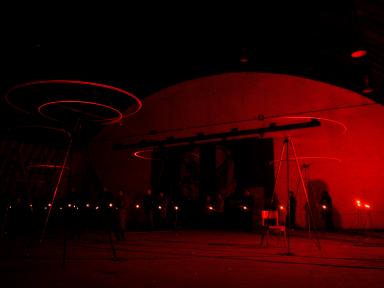Siren: waiting for the spaceship to land

If you thought you had Vancouver’s "PuSh Festival":http://pushfestival.ca/index.php figured out, think again. With *Siren* as this year’s opener, Executive Director Norman Armour cleans the slate and starts anew. More than anything, this sound installation by "Ray Lee":http://www.invisible-forces.com/ (Oxford, UK) is about expecting the unexpected.
Before entering the theatre at the Roundhouse Community Center, festival staff lay down rules that go beyond the usual “turn off your cell phones” and “no flash pictures.” We’re told we’re about to see a “promenade” performance, meaning we can walk around in the theatre. But we’re not to touch any part of the installation, and speaking is out of the question as it will interfere with acoustics. I find rules provocative. As a result I become very curious about what will be on the other side of the double doors leading into the performance space.
The theatre is dimly lit. The red brick walls and black curtains reach up past the lighting grid and disappear into the rafters. Configured across most of the floor space are upwards of 25 metal tripods, varying in height — the shortest at about waist level, the tallest reaching to about fifteen feet. A thin metal beam is balanced on each tripod. At either end of each beam is a black, can-shaped speaker. Two men in grey suits remain stationary amidst this landscape of tripods, which are evocative of hydro towers. Maybe that’s intentional. There’s a deep electrical hum emanating from somewhere. I discover I can affect the volume just by moving around the room.
Once the audience is in, the two men start ‘turning on’ the tripods. Each one emits an electric drone from a hand built generator, and each is somehow tuned with a small screwdriver. The ‘musicians’ (Lee and Harry Dawes) are very precise about this, fine-tuning one tripod before moving on to the next. Turning on a tripod includes switching on a pair of red lights, one at each end of the metal beam, and setting the beam turning so that the lights rotate around the beam’s axis. Layers of sound accumulate. After a while the room is vibrating with electric transmissions that, yes, initially bring to mind air-raid sirens. But they meld into a symphonic surge that never quite peaks, opting to remain in a state of tantalizing immanence. I can pick out individual threads by relocating myself in another part of the room. Sometimes I linger with the higher frequencies. Other times I back myself against a wall and let the force of the bass register overwhelm me.
I notice some people drifting about the installation with their eyes closed. But the visual is intoxicating as well: all these towers with spinning red lights; a silent procession of spectators flowing around them like pilgrims at a shrine.
Taking in Sirens is a bit like ingesting a mild hallucinogen, than waiting for the buzz to hit. And it does hit. Without warning the theatre lights go out and the spinning red dots are all I can see. It’s like watching fireflies from a back porch, except the porch is on Mars and the fireflies are red and following predetermined elliptical patterns. Each one traces its arc at a different rate. The velocity is increased. The overall acoustic pitch also seems to rise. Buzz buzz. Most of us have stopped moving. We’re waiting for the spaceship to land, or for the wormhole to appear. Eventually the spinning slows. I feel the disorienting warp of time. I’m being stretched.
One by one, the tripods stop spinning. Each one is turned off, subtracting sound from the overall composition, until there is silence in the room. The removal of manufactured sound opens my ears to the environmental sounds. Water in pipes, feet shuffling, people breathing.
It only lasts a few seconds. Too soon the curtain call occurs. And this is my one quibble with the show – now that my hearing has been re-tuned and the composition has ended, I want to linger with this other music. I’m beginning to feel the presence of the people I am with in a way I didn’t before. I feel the possibility of making contact. In fact, if we can be left to our own devices I feel that anything can happen, and that this must be what the experience was leading to. But it’s over and we’re clapping and I feel a little confused. Was it really just a concert? Did I miss an unspoken rule: “Please leave the theatre, the show is over. Do not touch your fellow spectators on the way out”?
I didn’t see anything like Siren at last year’s PuSh. It’s the kind of show that changes the festival’s parameters. I arrived with no expectations, and was delightfully surprised by what Ray Lee had to offer. I only wish I could have had the chance to return the favour.
_Siren is composed and devised by Ray Lee. Performed by Lee and Harry Dawes. Produced by Simon Chatterton. Technician: Stavroula Kounadea. For performance times, go_ "here":http://pushfestival.ca/index.php?mpage=shows&spage=main&id=69#show.



